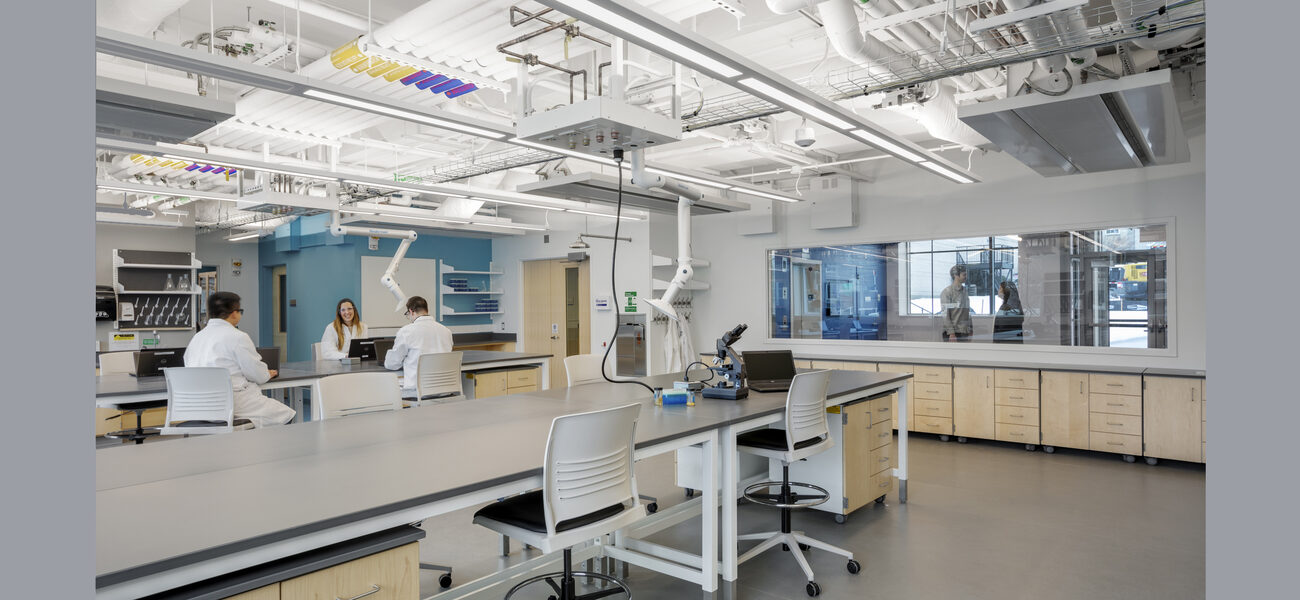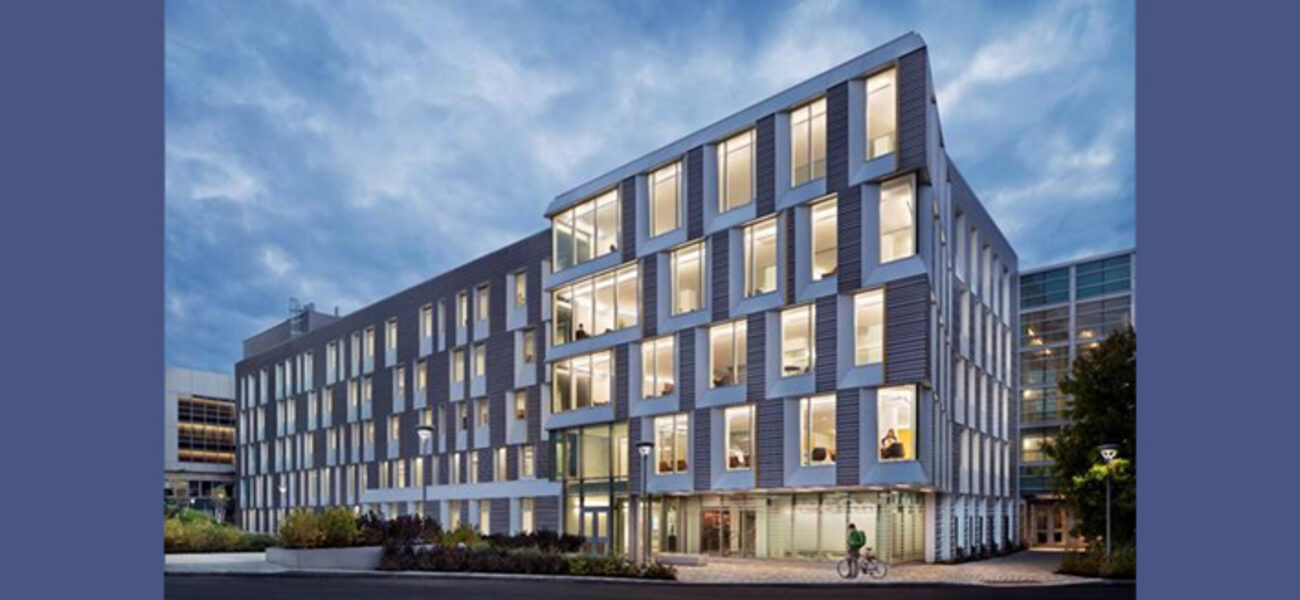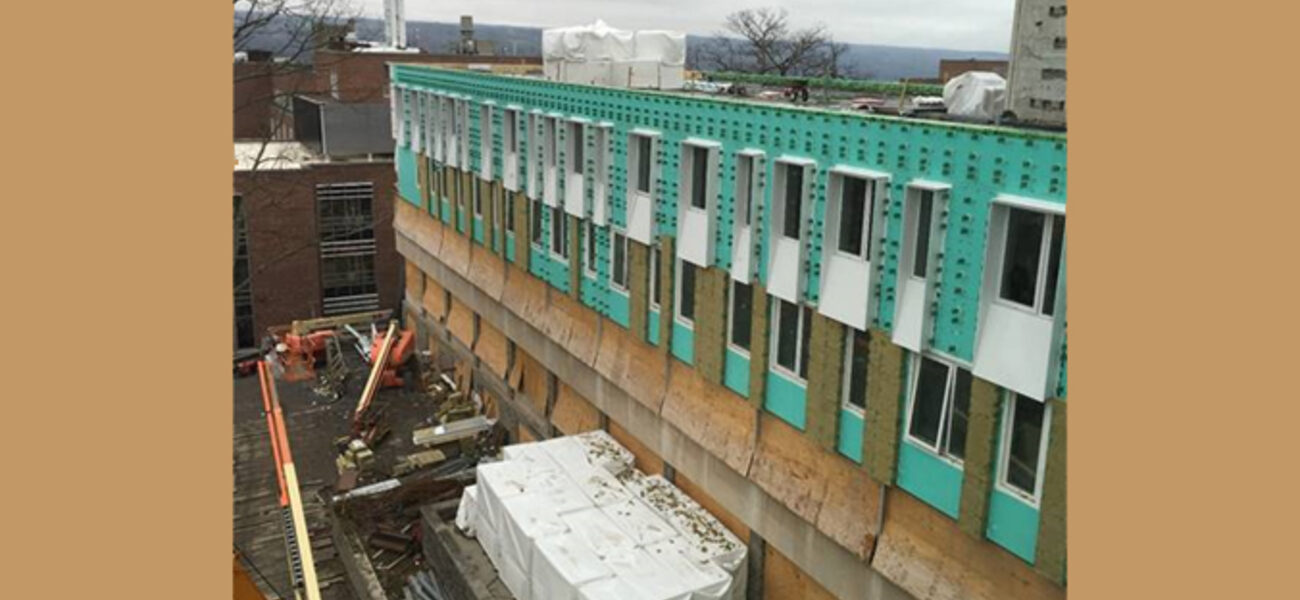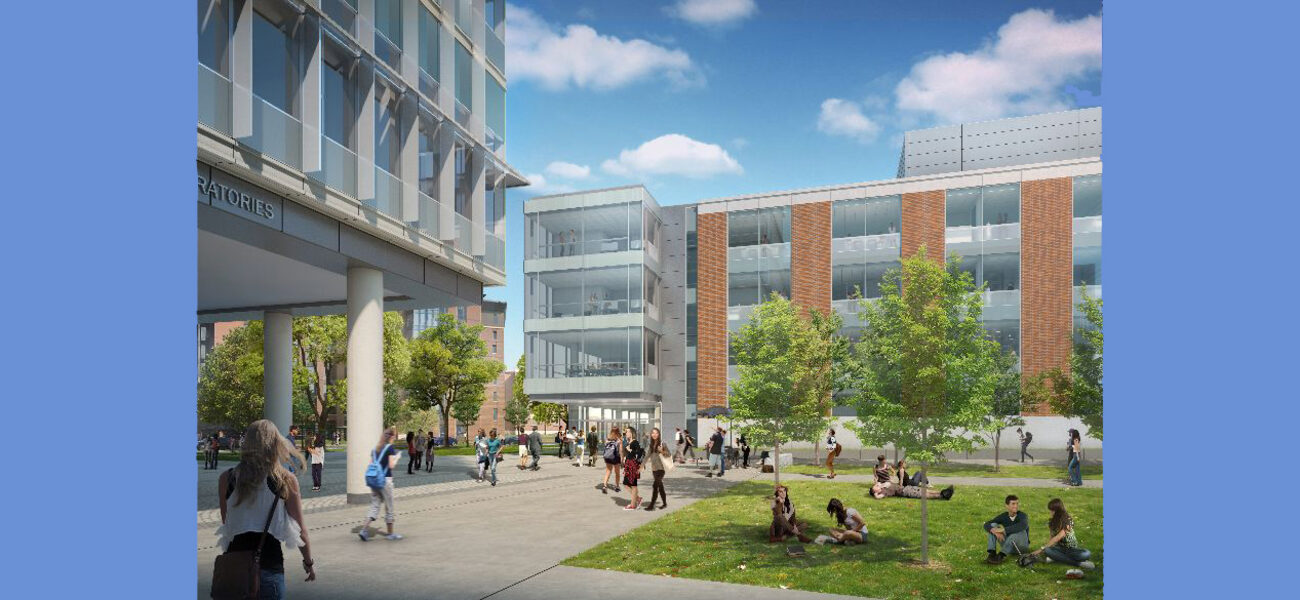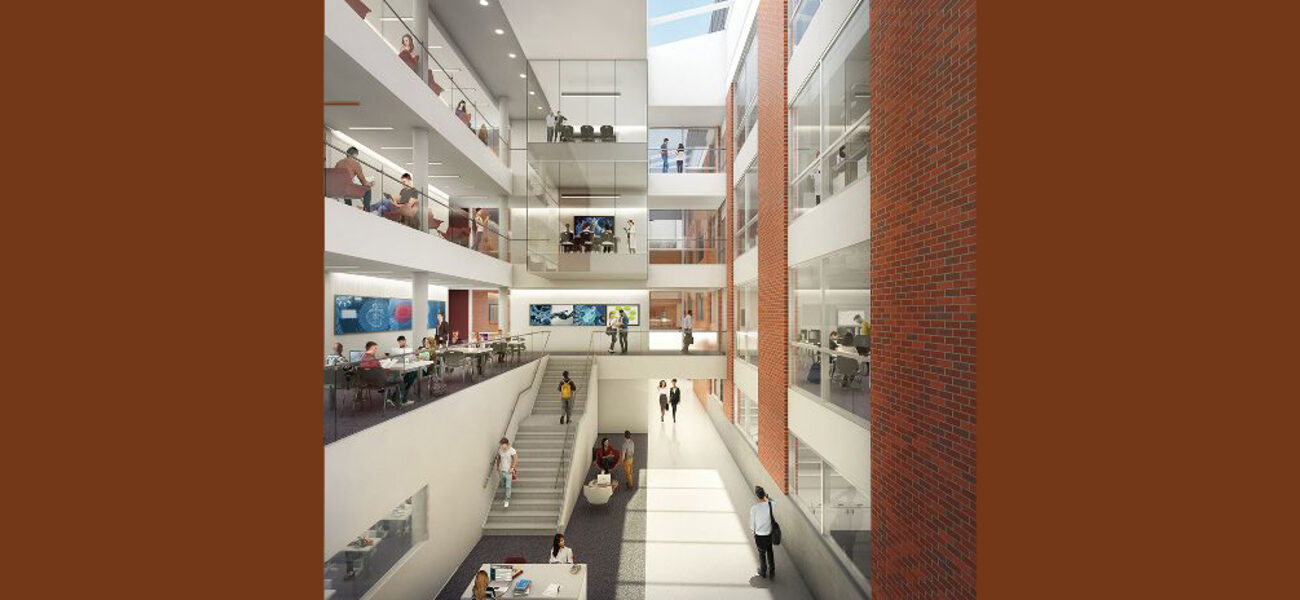Most academic science buildings constructed in the mid-20th century were not designed to support the interdisciplinary, collaborative, and entrepreneurial dynamics of modern engineering teaching and research that occupy these buildings today. While motivations for renovation can range from the need to update outdated building systems, to the desire to improve the school’s ability to recruit new talent and donors, most major renewal projects share similar challenges of aging infrastructure, complex logistics, and phased implementation. Using examples from recent renovations at Cornell University, Ohio State University, and the University of Massachusetts, principals from Perkins+Will share how these and other challenges can be addressed.
“In engineering, success is often about breaking down departmental silos, and we’re seeing traditional alignments of disciplines and departments blurring,” says Paul Harney, AIA, LEED AP, principal at Perkins+Will’s Washington, DC, office. “Regardless of whatever the department label happens to be, it is now very common in engineering to see the full gamut of scientific disciplines—such as biology, chemistry, physics; as well as engineering disciplines such as mechanical, electrical, materials, structural, civil—all mixed together. This is a result of research moving in a more transdisciplinary direction, and researchers needing access to a bigger collaborative toolbox of techniques, insights, and approaches from a wider variety of the traditional specialties within science and engineering.”
He explains that as interdisciplinary and transdisciplinary collaboration grows, the problems being tackled are more complex than ever before and often require heavier infrastructure and specialized equipment within labs to allow for more intense analysis and simulation.
“Today’s engineering buildings should aim to make sure every space in the building has a collaborative bent to it,” says Anthony Paprocki, AIA, LEED AP, senior associate in Perkins+Will’s Boston office. “Collaboration means more than just making space for two people to work together at the bench. It is about orchestrating direct and indirect forms of interactions between offices, classroom spaces, and labs.”
He adds that collaboration elements can include open labs that are on view to visitors, or virtual tools such as video conferencing.
“Increased collaboration in turn spurs new entrepreneurial ventures, and schools are continually looking for ways to transition students from academia to industry,” says Eileen Pedersen, AIA, LEED AP, BD+C, senior associate in Perkins+Will’s Minneapolis office. “Our challenge is to make sure that the buildings support this goal with spaces that are specified for integrated research, and flexible spaces that allow industry to tailor research to their needs.”
University of Massachusetts
Originally constructed in 1952, Perry Hall is a 54,000-sf facility within the Francis College of Engineering at the University of Massachusetts’ Lowell campus. The newly renovated facility was completed in January of 2019.
“The building’s overall layout was extremely closed due to a small floorplate and limited floor-to-floor height,” says Paprocki. “To counteract this, the renovation was intended to make the building layout much more open and flexible.”
While open laboratory design is not revolutionary, Paprocki explains that, for this facility, the idea pushed researchers to the edge of their comfort levels, because they were used to working in enclosed laboratories.
Every inch used for mechanical shaft space or utilities in the facility’s small floorplate was space that could not be used for research, so the university decided to restrict Perry Hall to what the school categorizes as “medium-service labs” used for both wet and dry research that does not require intensive hoods or large equipment.
Paprocki explains that since both sides of Perry Hall were connected to other buildings on the north campus, this offered an ideal way of framing a highly interactive and visible public corridor that runs through the building. The open lab environments are bracketed by shared core support spaces giving researchers easy access to support spaces, as well as to large open bench environments easily expandable if research groups need more space.
“The dean and everyone on the steering committee loved the idea of creating collision space using a visible framework to create a physically interactive building,” says Paprocki. “Everything from the building’s entry to the classrooms and labs reinforces the idea that the building is a mixing pot, where students, researchers and industry can physically run into each other and interact.”
He adds that indirect collision space includes teaching environments with windows onto the public corridor and lounge areas with views into lab environments.
Rather than creating traditional departmental labs, says Paprocki, UMass decided to create project-based or thematic labs that focus on the broader areas of biomedical engineering, biomanufacturing, and alternative energy.
“Using the open lab concept with this theme-based approach will intentionally mix people together in the same space who may not have worked together in the past,” he says.
Every floor in Perry Hall also has small 1,000- to 1,500-sf labs that are reserved as “industry spaces” intended to support future collaborative research between UMass and industry partners in an effort to increase entrepreneurial opportunities.
Cornell University
Completed in the summer of 2017, the renovation of 1950s-era Upson Hall is the first major stem-to-stern renovation within the College of Engineering at Cornell University.
“Upson Hall faced the challenges of excruciatingly low floor-to-floor heights, and decades of minor modifications here and there that ultimately conspired to make what was already a not very flexible building really inflexible,” says Harney. “Despite these challenges, Cornell did not have the swing space to relocate researchers during construction of an entirely new facility, so a renovation approach made the most sense both from an economic standpoint and also for the efficiency of allowing research to continue during construction.”
The project team, led by the partnership of Perkins+Will with LTL Architects, decided to phase construction vertically to accommodate ongoing research during renovations.
“The top three levels of Upson Hall were renovated first, allowing for the installation of new rooftop mechanical equipment, while the lower floors continued to operate with the original systems,” says Harney. “Once the upper floors were complete, the new mechanical systems were continued down into the lower floors during the second phase of the renovation.”
He adds that the original Upson Hall did not have air conditioning, which caused problems if lab occupants got too warm and opened windows, potentially disrupting temperature-controlled experiments.
“One of the overall goals for the renovation was to achieve a very high level of energy efficiency,” says Harney. “To accomplish this, all the original exterior cladding was stripped off and replaced with a new high-performance envelope system, since the original cladding was too thin to compensate for the cold winter climate in upstate New York.”
The interior was completely renovated, as well, with the creation of what Harney describes as a main street corridor that allows students and visitors to cut through the building and view engineering students at work, including an eye-catching double-height bay area that houses a unique rapid prototyping machine.
“As architects, we usually try to break down silos in research settings and often recommend open or shared laboratory spaces,” says Harney. “At Upson Hall, however, we agreed that sticking with the traditional closed-room lab still made the most sense. There is an astonishing variety of disciplines that fall under the mechanical and aerospace engineering umbrella, and an open-layout approach could not accommodate the wide variety of research with unique processes and equipment, often with issues of sensitivity to noise and vibration, biological or chemical containment, laser safety, or other factors that made sharing lab space inappropriate.”
“Rather than open labs, we created a lab template to facilitate renovation or customization as research evolves and new faculty comes in with new projects,” says Harney. “There is a very ordered system in how the mechanical, electrical and plumbing is handled in every lab space, and we kept the systems as exposed as possible to simplify future structural changes.”
The Ohio State University
Renovations on the Ohio State Biomedical and Materials Engineering Complex, originally built in 1960, are expected to be completed in June of 2020. According to Pedersen, the Ohio State project will have several open labs similar to Perry Hall at UMass, but will also include specialized labs more in line with Cornell’s Upson Hall.
Working together, Perkins +Will and Moody Nolan Architects of Columbus, Ohio, are renovating approximately 90,000 sf of the 123,000-sf building in the heart of OSU’s main campus. The project will add classrooms, labs, and administrative space for the Materials Science and Engineering (MSE) Department, which previously occupied the building, as well as create a new home for the Biomedical Engineering (BME) Department currently located remotely on the west side of campus.
The main goal of the project is to consolidate engineering resources while updating the building’s infrastructure, including demolition of a high bay area that became the building’s central atrium, says Pedersen, who describes the new atrium as the visual heart of the building and one of the main hubs for collaboration.
“Because of the constraints of the existing structure, there was no clear way to have the corridors stacked from floor to floor,” she says. “It was really a three-dimensional puzzle trying to determine which shafts and which spaces could penetrate the entire building, while still keeping an open floor plan with programs that varied from floor to floor.”
“The idea of having all of the principal investigators (PIs) and all of the grad students intermixed was definitely a challenge,” says Pedersen. “We tried to combine departments with compatible research goals and processes, and ideally co-locate researchers who could share equipment.”
She adds that several PIs in the BME were already sharing equipment, so it was natural for them to share space. However, within the MSE, certain aspects of research could not be mixed, such as a group studying corrosives, whose unique needs and processes were incompatible with sharing laboratory space.
“Despite wanting to achieve collaboration, there was still a strong desire among both departments to maintain their own identity,” she says. “We addressed this by making sure that each department still had separate administrative offices, despite the shared lab space.”
“When different departments are being merged together, there will inevitably be a variety of personalities and a variety of ways that departments could be organized, so it’s tricky for everyone,” she says. “Ultimately, it all comes down to right-sizing, finding the balance between what our clients actually need with some built-in flexibility and not overdesigning in order to stay in budget.”
By Amy Cammell
| Organization | Project Role |
|---|---|
|
Perkins&Will
|
Architects
|
